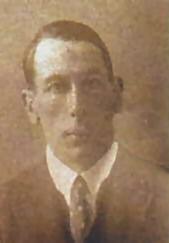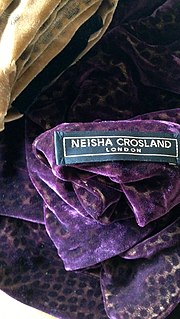
Wallpaper is a material used in interior decoration to decorate the interior walls of domestic and public buildings. It is usually sold in rolls and is applied onto a wall using wallpaper paste. Wallpapers can come plain as "lining paper", textured, with a regular repeating pattern design, or, much less commonly today, with a single non-repeating large design carried over a set of sheets. The smallest rectangle that can be tiled to form the whole pattern is known as the pattern repeat.
Marimekko Oyj is a Finnish textiles, clothing, and home furnishings company founded by Viljo and Armi Ratia in Helsinki in 1951. Marimekko made important contributions to fashion in the 1960s. It is particularly noted for its brightly colored printed fabrics and simple styles, used both in women's garments and in home furnishings.

The Silver Studio was one of the most influential textile design studios in the UK from its formation in 1880 until the middle of the twentieth century.

Morris, Marshall, Faulkner & Co. (1861–1875) was a furnishings and decorative arts manufacturer and retailer founded by the artist and designer William Morris with friends from the Pre-Raphaelites. With its successor Morris & Co. (1875–1940) the firm's medieval-inspired aesthetic and respect for hand-craftsmanship and traditional textile arts had a profound influence on the decoration of churches and houses into the early 20th century.

Jean Elizabeth Muir was a British fashion designer.

Charles Francis Annesley Voysey was an English architect and furniture and textile designer. Voysey's early work was as a designer of wallpapers, fabrics and furnishings in a Arts and Crafts style and he made important contribution to the Modern Style, and was recognized by the seminal The Studio magazine. He is renowned as the architect of several country houses.

Textile geometry is the creative and technical process by which thread or yarn fibers are woven together or interlaced to form a flexible, functional, and decorative cloth or fabric which is subsequently printed upon or otherwise adorned. Textile design is further broken down into three major disciplines, printed textile design, woven textile design, and mixed media textile design, each of which utilize different methods to produce a surface ornamented fabric for variable uses and markets. Textile Design as a practice has evolved to become an industry integral to other disciplines such as fashion, interior design, and fine arts.

Fashion design is the art of applying design, aesthetics, clothing construction and natural beauty to clothing and its accessories. It is influenced by culture and different trends, and has varied over time and place. "A fashion designer creates clothing, including dresses, suits, pants, and skirts, and accessories like shoes and handbags, for consumers. He or she can specialize in clothing, accessory, or jewelry design, or may work in more than one of these areas."

Charles André Mare (1885–1932), or André-Charles Mare, was a French painter and textile designer, and co-founder of the Company of French Art in 1919. He was a designer of colorful textiles, and was one of the founders of the Art Deco movement.

Désirée Lucienne Lisbeth Dulcie Day OBE RDI FCSD was one of the most influential British textile designers of the 1950s and 1960s. Day drew on inspiration from other arts to develop a new style of abstract pattern-making in post-war British textiles, known as ‘Contemporary’ design. She was also active in other fields, such as wallpapers, ceramics and carpets.

Mary Lillian White later Mary Dening was an English textile designer known for several iconic textile prints of the 1950s. Her designs were very popular and extensively copied in many 1950s homes, as well as in cabins aboard the RMS Queen Mary and at Heathrow Airport. She was also a commercial potter and ceramist, who in the 1960s founded Thanet Pottery, in partnership with her brother David White.

Kenneth Cobonpue is a Filipino industrial designer known for his unique designs integrating natural materials through innovative handmade production processes. He began his design career after his studies in Industrial Design in New York, which led him to apprenticeships and further studies in Italy and Germany.

Bizarre silks are a style of figured silk fabrics popular in Europe in the late 17th and early 18th centuries. Bizarre silks are characterized by large-scale, asymmetrical patterns featuring geometrical shapes and stylized leaves and flowers, influenced by a wave of Asian textiles and decorative objects reaching the European market in these decades. Bizarre silks were used for both clothing and furnishings. As a description, the term was first used by Dr. Vilhelm Sloman in the title of a book, Bizarre Designs in Silks published in 1953 in Copenhagen.
Hammer Prints Limited was a company founded in 1954 by Nigel Henderson and Eduardo Paolozzi.

Neisha Crosland is a British-born, London-based textile designer, who works in the fields of furnishing fabric, wallpaper and interiors products. Her designs have featured in the ranges of British brands such as Osborne & Little and John Lewis. Internationally, her work is also recognised and she has a collection for Hankyu department stores in Japan.
Marion Victoria Dorn also known as Marion Dorn Kauffer was a textile designer primarily in the form of wall hangings, carpeting and rugs, however she is also known to have produced wallpaper, graphics, and illustrations. Known for her significant contributions to modern British interiors in particular for her 'sculpted' carpets, she contributed to some of the best-known interiors of the time including the Savoy Hotel, Claridges, the Orion and the Queen Mary. In the late 1930s and early 1940s she created moquette fabric designs for use in London Transport passenger vehicles.
Joseph Dirand is a French architect and interior designer based in Paris.

LED wallpaper is the integration of light-emitting diodes into flat substrates suitable to be applied to walls for interior decoration purposes.

William Morris (1834-1898), a founder of the British Arts and Crafts movement, sought to restore the prestige and methods of hand-made crafts, including textiles, in opposition to the 19th century tendency toward factory-produced textiles. With this goal in mind, he created his own workshop and designed dozens of patterns for hand-produced woven and printed cloth, upholstery, and other textiles.
Maria May was a German textiles designer with commercial flair. The scope of her output also embraced other forms of large-format wall art such as mosaics and posters. High-profile commissions included the large mosaic, "Tiefsee" she produced for the ball room of newly built ocean liner SS Bremen (1928) and a large set of sprayed silk wall tapestries that she produced in collaboration with Otto Arpke for the cabin interiors of the LZ 129 Hindenburg airship. Between 1956 and 1966 she served as head of the "Meisterschule für Mode" in Hamburg.














